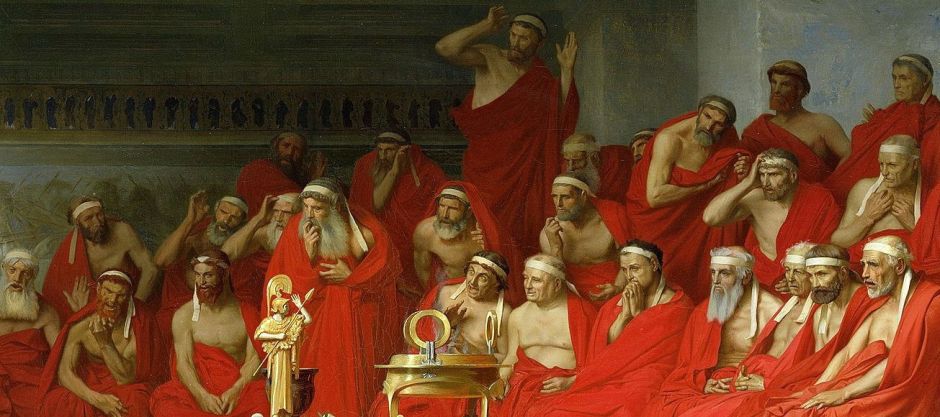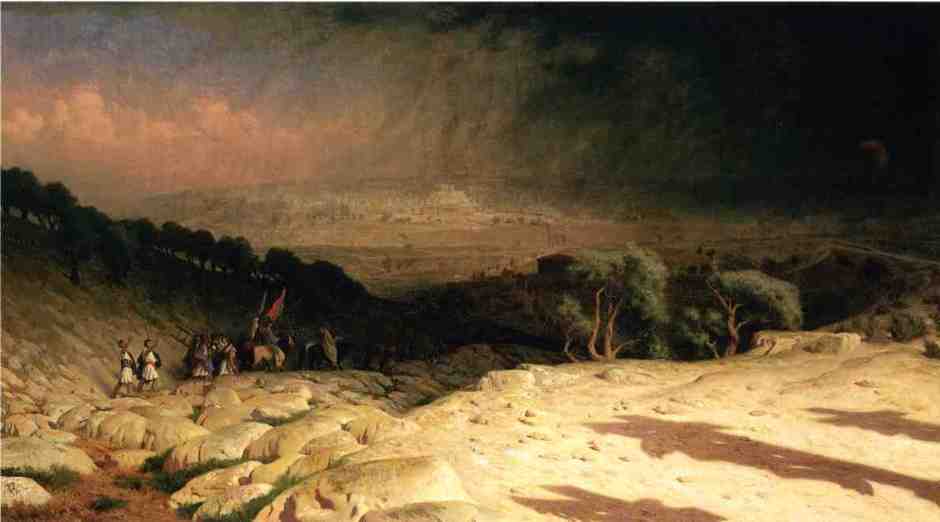Visual artists, by definition, have an interest in vision and seeing, but few made it as recurrent a theme as Jean-Léon Gérôme. This weekend I look at a few of his paintings about vision, visual fidelity, and the new art of photography, covering a period of over fifty years. Gérôme was one of the last great academic Realists, an outspoken critic of Impressionism but an enthusiastic supporter of photography. At the height of his popularity he and Goupil his dealer made a small fortune, but by the end of the nineteenth century he was forgotten and neglected.

Among his early works, it is Gérôme’s relatively small and simple painting of Michelangelo from 1849 which is the most enigmatic. Michelangelo is shown in his dotage, hunched and blind, being led by a young boy whose dress would have aroused his master’s homoerotic desires. The broken sculpture is the Belvedere Torso, a huge fragment of marble statuary which was so loved by the sculptor that it was nicknamed the School of Michelangelo. The young boy is leading his master’s hands to stroke and caress the marble, now that he’s unable to enjoy looking at its classical and very male form.
This is the first sign of Gérôme’s developing theme of sight, and the role of vision in establishing truth. In his blindness, Michelangelo can only feel what we can see, and cannot see the figure of the young boy. This is particularly appropriate to Gérôme, who quite late in his career became a successful sculptor himself.

Gérôme met more criticism when he exhibited Grecian Interior, Le Gynécée in the Salon of the following year. It has been disputed as to whether the scene depicted here is that of Messalina’s legendary brothel, or was inspired by a poem by Simonides of Amorgos considering the temperament of women. Its title states that it shows the women’s area or gynaeceum within a large Greek house, where the unmarried women relaxed and socialised with one another, a refuge to which the ‘woman of the house’ would return when not with her husband.
This is Gérôme’s first classical painting that he filled with small clusters of apparently random objects; for example, at the right edge, and around the shrine to the left of centre. He became almost obsessive in decorating his classical paintings with all sorts of bric-a-brac, like an old curiosity shop. Although he researched these extensively, many are now considered to be inappropriate or anachronistic, and some are just odd. Like the fine detail on the tiled floor, they enhance the impression of reality, giving many of his paintings what would now be termed a photographic quality over eighty years before colour photography became common.

Nearly a decade later in his Ave Caesar, Morituri Te Salutant (1859), Gérôme depicted the spectacle of the Colosseum in Rome. The story is simple, going no deeper than a translation of its title, Hail Caesar! We who are about to die salute you. A group of gladiators clustered in front of Caesar are just about to join the bodies of the last ones, who are still being dragged away by slaves. Consternation was raised in the depiction of the Vestal Virgins, carefully positioned between the gladiators and Caesar, watching and enjoying such a depraved spectacle.
Despite its popular appeal, there is more to Ave Caesar than its expansive view and the roar of the crowd. The viewer is, as in so many of Gérôme’s paintings, not only looking at the spectacle, but also at those looking at the spectacle, ultimately themselves.

That same year, Gérôme painted the strange legend of King Candaules (1859). According to legend, King Candaules of Lydia boasted of the beauty of his wife, Nyssia, to the chief of his personal guard, Gyges. To support his boast, the king showed his wife to Gyges by stealth, naked as she was preparing for bed. When she discovered Gyges’ voyeurism, Nyssia gave him the choice of being executed, or of murdering the king. Opting for the latter, Gyges stabbed the king to death when he was in bed, then married Nyssia and succeeded Candaules on the throne.
The king is in his bed, awaiting his wife, who has just removed the last of her clothing as she spots the dark and hooded figure of Gyges watching her from the open door. Gérôme’s love of detail in the decor saves this from the accusation that it was just another excuse for a full-length nude. Instead, it’s surely about voyeurism and looking, a theme he was to develop further two years later, in Phryné Before the Areopagus (1861).

Phryne was a highly successful and rich courtesan (hetaira) in ancient Greece who, according to legend, was brought to trial for the serious crime of impiety. When it seemed inevitable that she would be found guilty, one of her lovers, the orator Hypereides, took on her defence. A key part of that was to unveil her naked in front of the court, in an attempt to surprise its members, impress them with the beauty of her body, and arouse a sense of pity. The legend claims that this ploy worked perfectly.

Phryne is to the left of centre, in the midst of the semicircular court, completely naked apart from some jewellery on her neck and wrists, and her sandals. She is turned away from the gaze of the judges, her eyes hidden in the crook of her right elbow, as if in shame and modesty. Behind her (to the left), her defence has just removed her blue robes with a flourish, his hands holding them high. At Phryne’s feet is a gold belt of a kind worn to designate courtesans in France from the thirteenth century, with the Greek word ΚΑΛΗ (kale), meaning beautiful.

The judges, all men with bare chests and wearing uniform scarlet robes, are taken aback. Gérôme shows a whole textbook of responses from pure fright, to anguish, grief, or disbelief, with each of those men looking straight at Phryne.
Superficially, it’s easy to suggest that Gérôme was using Phryne’s nakedness to appeal to the lowest desires, which remained one of the popular attractions of the annual Salon. However it’s more likely that this is a statement about attitudes to the nude female form, the judgement of the Salon, voyeurism and looking.
In 1864, Gérôme became one of the early painters to use photography as an aid.

Gérôme articulated Napoleon III’s aspirations for empire in his elaborate formal painting of the Reception of Siamese Ambassadors by Napoleon III (1864), depicting a grand reception held at Fontainebleau on 27 June 1861. Gérôme had attended in the role of semi-official court painter as he was commissioned by the State, made sketches of some of the key figures, and was further aided by photographs made by Nadar. A decade later, the First Impressionist Exhibition was held in Nadar’s former studio.

Gérôme was by his own admission not a religious man, and painted few religious works. Of those Golgotha (Consummatum Est, or Jerusalem) (1867) is striking for its use of the shadows of the crucified, and for its exploration of the play of light, which was to become so central to Impressionism.
References
Ackerman GM (2000) Jean-Léon Gérôme, Monographie révisée, Catalogue Raisonné Mis à Jour, (in French) ACR Édition. ISBN 978 2 867 70137 5.
Scott Allan and Mary Morton, eds. (2010) Reconsidering Gérôme, Getty. ISBN 978 1 6060 6038 4.
Gülru Çakmak (2017) Jean-Léon Gérôme and the Crisis of History Painting in the 1850s, Liverpool UP. ISBN 978 1 78694 067 4.
de Cars L et al. (2010) The Spectacular Art of Jean-Léon Gérôme (1824-1904), Skira. ISBN 978 8 85 720702 5.

